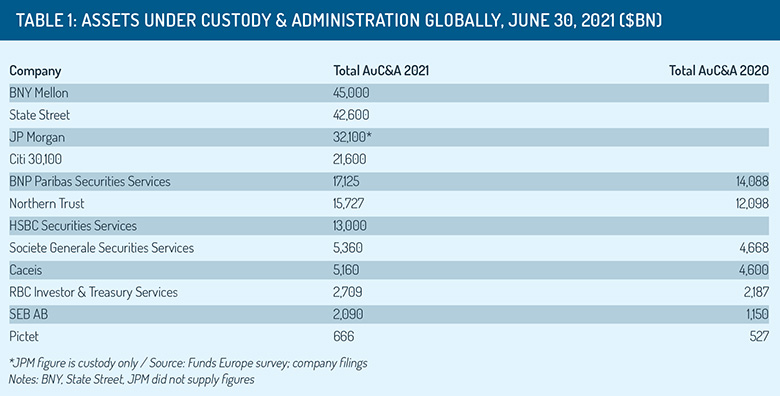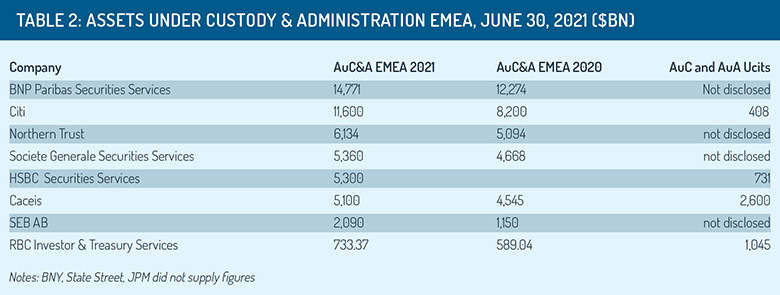A lag exists between asset managers who want to move on digital assets, and back offices that are working to be operationally ready, finds Lynn Strongin Dodds. Plus, tables from our 2021 asset servicing survey.
The digital asset landscape is a work in progress with various initiatives, regulations and use cases moving at different paces. However, the direction of travel is clear, and these products will be part of the fund management ecosystem in one form or the other. It is no surprise then that market participants are looking for asset servicing firms who are agile and innovative.
The interest is reflected in the recent Coalition Greenwich study on behalf of Fidelity Digital Assets which showed that around 90% of the 1,100 global institutions surveyed expect their company’s or their clients’ portfolios to include digital asset investments within the next five years. There are different products, but the common denominator is that they are created and maintained on a distributed ledger, or blockchain.
Today, cryptocurrencies seem to be the favourites among retail investors, family offices, high-net-worth individuals and hedge funds. They are decentralised currencies and aim to be a store of value, or a medium of exchange. There are more than 4,000 cryptocurrencies but bitcoin, and to a lesser extent ethereum, XRP, litecoin and bitcoin cash, dominate the scene.
Institutional investors, on the other hand, are more interested in security tokens, which are liquid representations of traditional assets that are easy to trade and can be bought in smaller fractions. That means that large illiquid assets such as real estate can, at least in theory, be divided into tokens that can be sold.
Both cohorts, though, share the same concerns about them, according to the Coalition Greenwich study. These range from the volatility of cryptocurrencies to the lack of transparency and availability of tools and analytics to gauge their value. European pension funds have also added regulatory ambiguity and market manipulation to their list of worries. This explains why, for now, many are waiting on the sidelines until a clearer legislative blueprint emerges.
“At the moment there is a lag between asset managers who are talking about making a move, and back offices that are already working to be operationally ready,” says Ashley Sheen, partner at consultancy Sionic. “One of the issues is that firms are trailing the regulatory landscape. It is a bit like the Wild West, with very few established rules and regulations.”
Securities or commodities?
Currently, the main pieces of legislation coming through the system are the European Commission’s Markets in Crypto-Assets (MiCA) proposals, which are part of the EU’s overall Capital Markets Union. The goal is to establish a regulated and structured market environment that is aligned with the more traditional financial instruments of equities, bonds, structured products, credit and rates derivatives.
In the US, a major debate continues to rage on as to whether digital assets are a security or commodity. It depends on which regulator is questioned – the Securities and Exchange Commission (SEC) treats them as securities, while the Commodity Futures Trading Commission (CFTC) would call them the latter. Arguably, the general consensus is that the SEC could regulate bitcoin and other decentralised tokens as securities.
Against this uncertain legislative backdrop, custodians are moving at their own speed in terms of approaches, products and solutions. Some firms, such as Pictet, would like to see more maturity before taking the plunge into digital assets. “The feedback we are getting from institutional fund managers is they are more interested in the underlying technology and potential of token assets,” says Marc Briol, CEO of Pictet Asset Services. “At the moment we do not offer custody solutions and do not think there is a first-mover advantage, but [there is a] last-mover disadvantage. One of the challenges is how can you properly assess the liquidity on platforms and how do you properly segregate positions?”
Some other asset servicing firms that perhaps have moved more substantially are catering for cryptocurrencies because these are the most popular type of digital asset, particularly with retail clients. However, firms who are trading them are required to continue using custody services.
Many of the leading lights in custody, though, have greater ambitions and have been laying the groundwork for a broader product and service offering that grows with their clients’ growing acceptance of digital assets.

Ironically, despite the complexities of these investments, investors are looking for a similar menu of solutions that come with their more conventional assets.
As the recent Deloitte report – ‘A Market View of Custody on Digital Assets’ – points out, the number-one priority is to have custodians who focus on safeguarding the assets and ensuring the internal operating procedures, hardware, software and people are designed to protect any asset under custody, not just in the present but in light of future technological developments.
Also high on the checklist is the ability to keep abreast of regulatory as well as market developments, and to maintain a two-way conversation with regulators. The view is these discussions will ensure that there is transparency on the services provided by the custodian and the activities adhere to the services authorised.
Last but certainly not least is in the absence of regulatory certainty, custodians could take the lead in setting the market standard practices and instilling self-monitoring mechanisms based on discussions with regulators.
Wayne Hughes, head of digital assets at BNP Paribas Securities Services, also believes that the fundamental services offered by custodians will not be that different. He notes that clients still want to have their assets safeguarded, regulatory requirements fulfilled, and overall investment processes simplified.
However, he adds: “Our clients invest in a wide range of asset classes, and this can be complicated. We are spending a lot of time and effort to optimise the model to allow traditional and digital assets to co-exist within portfolios.
“Our guiding principle is to make the process as seamless as possible, allowing our clients to leverage their existing set-up and channels with us to cover both types of assets.”
New solutions
Justin Chapman, global head of market advocacy and innovation research at Northern Trust, echoes these sentiments. He also does not expect the custodian’s primary safekeeping role to change but does think digital assets need new, innovative digital solutions.
“We are at the early stages, but we have initiatives across the board – security tokens, stablecoins, cryptocurrencies and central bank digital coins,” he says. “Our job is to support the client and bring things together in a frictionless way to maximise the investment and liquidity for the client. This requires the ability to reimagine what the next ten years will be like, invest and re-engineer the technology.”
He notes that part of Northern Trust’s plan is embedded in its 2030 vision, which involves providing analysis and investment decision-making surrounding access to digital assets and cryptocurrencies.
The US-based firm also joined forces last year with Standard Chartered to launch Zodia, an institutional-grade custody solution for cryptocurrencies.
Meanwhile, State Street debuted its digital division, State Street Digital, in June after the Boston-based bank was appointed by Iconic Funds to serve as the administrator of a bitcoin-backed exchange-traded note listed on the Frankfurt Stock Exchange. The service, which will leverage its proprietary GlobalLink technology platform, will cover crypto as well as central bank digital currency, blockchain, and tokenisation.
Swen Werner, global product manager at State Street Digital, believes solutions will change as the regulatory picture becomes clearer. “We are in the process of defining the business model since the role of the custodians will expand in light of tokenisation,” he says.
“However, there are still several questions out there such as data privacy for distributed networks and whether data should be visible to all participants or disclosed only to the relevant counterparties. What is and isn’t permissible when it comes to crypto and what do you do with regulated funds such as Ucits which may not be allowed to invest in cryptocurrencies.”;

Building an integrated, institutional-quality digital and traditional asset servicing business model to meet the demands of clients will, of course, require scale and deep pockets. “The real challenge for firms is to understand the value of the services and what the price points are,” says Sheen at Sionic.
“It is hard to differentiate, and I think what we will see is some who will emerge from the pack and will execute good solutions, while others will do less well. There will also be room for specialists who can provide services for a particular market.”
© 2021 funds europe





